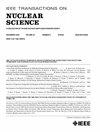质子辐射对低通量P-on-N短波红外HgCdTe焦平面阵列的影响
IF 1.9
3区 工程技术
Q3 ENGINEERING, ELECTRICAL & ELECTRONIC
引用次数: 0
摘要
本文研究了质子辐射对低通量P-on-N短波长红外(SWIR)碲化汞镉(HgCdTe或MCT)焦平面阵列(fpa)的影响。这项研究的动机是需要调查和表征质子辐照在这种装置上引起的降解。使用63 mev质子进行了三个步骤的辐照,累积通量高达4.7 \乘以10^{11}$质子/cm2。辐照后观察到暗信号退化。在最后的通量下,降解呈线性演变,最高暗信号达到2.6 e−/s,在室温下经过一个热循环后完全退火。在辐照步骤中入射质子的像素对像素计数也揭示了暗信号在超过100 k像素的大统计量上的线性退化。利用设施剂量计和本研究开发的入射质子计数法获得的通量估计了降解指数。使用两种方法获得的值相似,给出了在我们的传感器技术中计算63-MeV质子辐照后降解指数的稳健方法。本文章由计算机程序翻译,如有差异,请以英文原文为准。
Proton Radiation Effects on Low-Flux P-on-N Short-Wavelength Infrared HgCdTe Focal Plane Array
This article investigates the effects of proton radiation on low-flux P-on-N short-wavelength infrared (SWIR) mercury-cadmium-telluride (HgCdTe or MCT) focal plane arrays (FPAs). The study is motivated by the need to investigate and characterize the degradation induced by proton irradiation on such devices. Three steps of irradiation were conducted using 63-MeV protons with a cumulative fluence up to $4.7 \times 10^{11}$ protons/cm2. Dark-signal degradation was observed after irradiation. The degradation evolved linearly up to the final fluence, with the highest dark signal reaching 2.6 e−/s, and annealed completely after a thermal cycle at room temperature. A pixel-to-pixel count of incident protons during an irradiation step also revealed a linear degradation of the dark signal over a large statistic of more than 100 k pixels. A degradation index was estimated using the fluence obtained with the facility dosimeter and the incident proton count method developed in this study. The values obtained are similar using both methods, giving a robust method of calculation of the degradation index following 63-MeV proton irradiations in our sensor technology.
求助全文
通过发布文献求助,成功后即可免费获取论文全文。
去求助
来源期刊

IEEE Transactions on Nuclear Science
工程技术-工程:电子与电气
CiteScore
3.70
自引率
27.80%
发文量
314
审稿时长
6.2 months
期刊介绍:
The IEEE Transactions on Nuclear Science is a publication of the IEEE Nuclear and Plasma Sciences Society. It is viewed as the primary source of technical information in many of the areas it covers. As judged by JCR impact factor, TNS consistently ranks in the top five journals in the category of Nuclear Science & Technology. It has one of the higher immediacy indices, indicating that the information it publishes is viewed as timely, and has a relatively long citation half-life, indicating that the published information also is viewed as valuable for a number of years.
The IEEE Transactions on Nuclear Science is published bimonthly. Its scope includes all aspects of the theory and application of nuclear science and engineering. It focuses on instrumentation for the detection and measurement of ionizing radiation; particle accelerators and their controls; nuclear medicine and its application; effects of radiation on materials, components, and systems; reactor instrumentation and controls; and measurement of radiation in space.
 求助内容:
求助内容: 应助结果提醒方式:
应助结果提醒方式:


